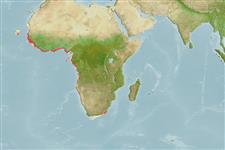Teleostei (teleosts) >
Lophiiformes (Anglerfishes) >
Antennariidae (Frogfishes)
Eponymy: Henry Weed Fowler (1878–1965) was an American herpetologist, ornithologist, ichthyologist and artist. [...] (Ref. 128868), visit book page.
Environment: milieu / climate zone / depth range / distribution range
Ecology
Marine; brackish; demersal; depth range 10 - 80 m (Ref. 27000). Tropical
Eastern Atlantic: Morocco to Angola (Ref. 7394, 57225).
Size / Weight / Age
Maturity: Lm ? range ? - ? cm
Max length : 28.5 cm SL male/unsexed; (Ref. 7394)
Dorsal spines (total): 3; Dorsal soft rays (total): 11 - 14; Anal spines: 0; Anal soft rays: 6 - 10. Diagnosis: body short and globose; mouth large with many small, villiform teeth; skin rough, covered with bifurcate dermal spinules; pectoral-fin lobes attached to sides of body; illicium at most as long as second dorsal-fin spine; large, conspicuous ocellus below dorsal fin on either side of body (Ref. 57225).
Body shape (shape guide): short and / or deep; Cross section: compressed.
Neritic species (Ref. 10959). Occurs in marine or brackish water (Ref. 57225).
Life cycle and mating behavior
Maturity | Reproduction | Spawning | Eggs | Fecundity | Larvae
Oviparous.
Travers, R.A., 1992. Mastacembelidae. p. 848-857. In C. Levêque, D. Paugy, and G.G. Teugels (eds.) Faune des poissons d'eaux douces et saumâtres d'Afrique de l'Ouest Tome 2. Coll. Faune Tropicale n° 28. Musée Royal de l'Afrique Centrale, Tervuren, Belgique and O.R.S.T.O.M., Paris, France, 902. (Ref. 7394)
IUCN Red List Status (Ref. 130435: Version 2025-1)
Threat to humans
Harmless
Human uses
Tools
Special reports
Download XML
Internet sources
Estimates based on models
Preferred temperature (Ref.
123201): 19.2 - 27.9, mean 25.9 °C (based on 66 cells).
Phylogenetic diversity index (Ref.
82804): PD
50 = 0.5312 [Uniqueness, from 0.5 = low to 2.0 = high].
Bayesian length-weight: a=0.02630 (0.01029 - 0.06725), b=2.96 (2.73 - 3.19), in cm total length, based on LWR estimates for this (Sub)family-body shape (Ref.
93245).
Trophic level (Ref.
69278): 4.2 ±0.73 se; based on food items.
Resilience (Ref.
120179): High, minimum population doubling time less than 15 months (Fec assumed to be > 10,000).
Fishing Vulnerability (Ref.
59153): Low vulnerability (25 of 100).
🛈
